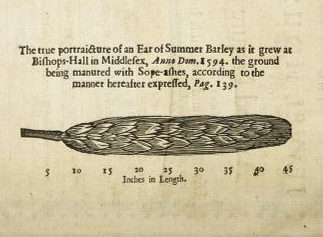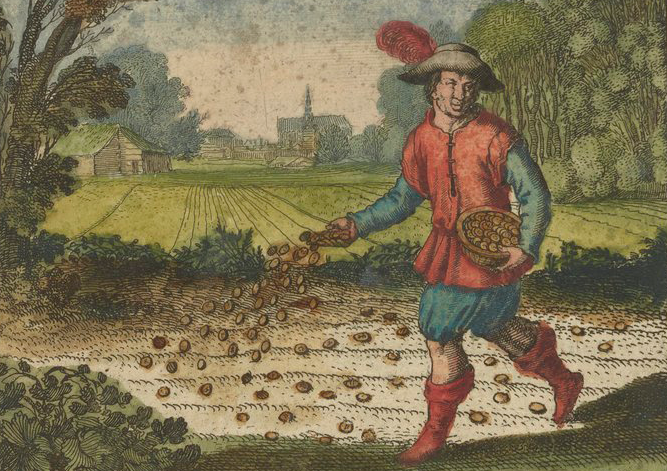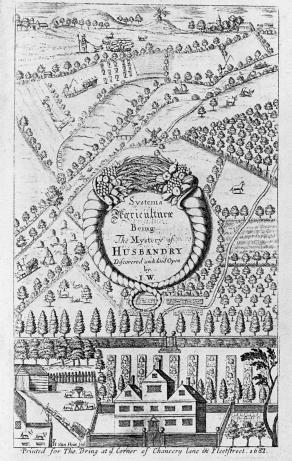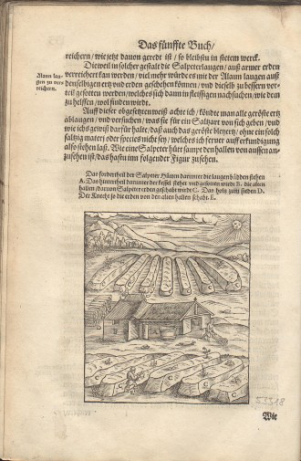For those in the early modern period, alchemy was well suited to answer such questions. Though best known for their attempts to turn lead into gold and prolong human life with chemical elixirs, alchemists waded into far deeper intellectual waters, with agrarian reformers in the sixteenth and seventeenth centuries adopting the theories and practices of alchemy to make agriculture a more productive enterprise. For them, alchemy was more than a secretive, hermetic art practiced in laboratories, workshops, and princely courts, but an expansive worldview that explained physical and chemical change in the cosmos and on Earth. It was also set of practices that could be applied in multiple work spaces where generation, growth, and material transformation required explanation, such as farms, kitchens, orchards, and gardens. And, it was a chemical technology that they believed could improve agricultural practices by boosting soil fertility, accelerating the germination speed of seeds, and conferring disease resistance to plants. Ultimately, my project “Agricultural Uses of Alchemy in Early Modern Europe” explores how such alchemical theories and practices played a small but vital role in the agricultural revolution in early modern Europe.

Evidence of enlarged barley stalks based on a recipe using calcined soap ashes. Source: Hugh Plat, The Jewel House of Art and Nature (London, 1594), [sig.] A1v. Public Domain.
Ideas of a Universal Life Spirit
The idea that alchemy could improve agriculture developed over the course of the sixteenth century, as alchemists began incorporating vitalist interpretations of matter into their work by envisioning a single life force responsible for growth and change in plants, animals, and minerals. Though Western alchemy had been largely devoid of vitalist notions during the Middle Ages, new theoretical schools of alchemy emerged in the sixteenth century asserting that a vital force (spiritus mundi or spiritus vitalis) was present in all matter and accounted for the generation and growth of metals, minerals, and plants. In these interpretations, alchemists claimed that all matter was endowed with “seeds” (semina), “sperm” (sperma), or an “agentive force” (archeus), which accounted for transformation across metallurgical and botanical domains. They also claimed that they could experimentally isolate them and harness them for the good agriculture.

Michael Maier, “Emblema VI. Seminate Aurum Vestrum in Terram Albam Foliatam.” In Atalanta Fugiens. Oppenheim, Germany: Johann-Theodor de Bry, 1618. Source: https://digital.sciencehistory.org/works/zk51vh57b. Courtesy of the Science History Institute, Philadelphia, Pennsylvania, USA.
Alchemy in the Field
Those most involved in putting alchemy to agricultural use were members of the Hartlib Circle. This loose network of scholars and social reformers—named after the polymath Samuel Hartlib—shared the results of experiments and engaged in theoretical discussions on themes from alchemy, mineralogy, and mathematics to trade policy, educational reform, and the English settlement of Ireland. Members were enthusiastic about all manner of schemes devoted to improving social welfare, relieving poverty, increasing public revenues, and reforming political structures, and in particular about agricultural projects. For the Circle’s agrarian reformers, theories and practices of alchemy represented more than transmuting lead into gold but rather transforming any natural substance to solve practical problems related to agriculture.
In one venture, agricultural reformers like Benjamin Worsley and Cheney Culpeper attempted to repurpose saltpeter manufacturing centers—then in use to supply the army with gunpowder—to produce artificial fertilizers based on the alchemical belief that saltpeter was the “vegetable salt” that contained the vital force that made life possible. In another, agrarian experimenters like Robert Child and Henry Jenney used alchemical recipes to modify seed steeps—liquids in which to soak seeds before planting—to create what they called “fructifying waters,” or chemical mixtures designed to boost fertility or guard against insects and rodents. The apple orchard proprietor and promoter of all manner of agricultural experiments John Beale wrote an unpublished treatise describing the grafting of trees as an alchemical process that “transmuted and improved” the new plants that emerged.
Those involved in the long-term project of agricultural improvement often described their goals in explicitly alchemical language. Some compared the use of compost as fertilizers to the alchemical process of putrefaction (nigredo) to explain how death led to new life. Others proposed that a seed’s ability to produce a plant that generated more seeds was equivalent to the alchemical power of multiplication (multiplicatio), which amplified the potency of the philosophers’ stone to allow for transmutation. For many more, the concept of alchemical transmutation (transmutatio) became a broad and comprehensive category of physical change that applied not just to the realm of minerals and metals but to plants and animals as well. By challenging traditional ecological knowledge with cutting-edge alchemical research, these reformers became engaged in the early modern version of environmental engineering. Their vision was a scientifically-grounded utopia free from scarcity and deprivation, or as they put it, the “recreation of Eden on Earth.”

A seventeenth-century husbandry manual. These popular texts incorporated more alchemy, chemistry, and mineralogy throughout the century. Source: John Worlidge, Systema Agriculturae, Being the Mystery of Husbandry Discovered and laid open (London, 1698), frontispiece. Public Domain.

A mid-sixteenth-century German artificial saltpeter manufacturing center. Lush plant growth on saltpeter mounds suggested fertilizing possibilities. Source: Lazarus Ercker, Beschreibung allerfürnemisten mineralischen Ertzt und Berckwercksarten (Prague, 1574), fol. 134. Public Domain.
Responding to Present-Day Ecological and Economic Challenges
Present-day environmental crises have raised awareness of the negative impacts humans can have on soil nutrient cycles and natural Earth systems through industrial chemical agriculture. With these challenges in mind, this project engages with early modern examples of the difficulties—both practical and ethical—involved when humans intercede in local ecologies. It pays special attention to unresolved tensions over whether early modern alchemists and agricultural reformers envisioned nature as a practically infinite, exploitable resource fully under humanity’s dominion or as a fragile, finite territory in need of stewardship, conservancy, and care. Many mid-seventeenth-century agrarian reformers were social utopians with dreams of limitless economic growth who believed that human ingenuity—buttressed by empirical science and experimentalism, but constrained within prescribed divine parameters—could create agricultural and financial bounty irrespective of any natural limits. They were the forward-looking futurists of the early modern era, entangled with the rise of capitalism and imperialism, and optimistic about the potential for science to be a force of change for public good. Understanding how their worldview shaped their scientific engagement with nature provides early modern examples for many of the same ecological and economic challenges we face today.

A heat map of the locations of Samuel Hartlib’s correspondents, ca. 1640–1660. Source: Scott B. Weingart, scottbot.net.
